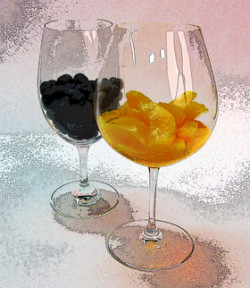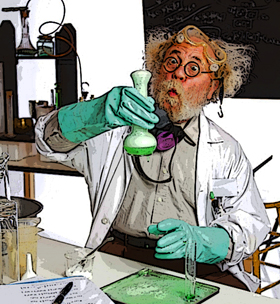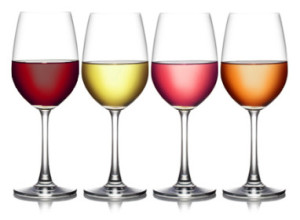Of Esters & MLFs.
Chapter Twelve. Parts Three & Four.
The Ester Ouster
 So what makes Cabernet Sauvignon smell like black currants and Viognier smell like peaches? The answer is only skin-deep – much like Jessica Simpson’s appeal or an outbreak of shingles.
So what makes Cabernet Sauvignon smell like black currants and Viognier smell like peaches? The answer is only skin-deep – much like Jessica Simpson’s appeal or an outbreak of shingles.
The cellular make-up of grape skins hold barely detectable aromatic compounds that are magnified during fermentation. Without fermentation these compounds would remain trapped inside the grape skins and then this would be a boring blog about grapes that no one will read … as opposed to a boring blog about wine that no one will read.
The cellular make-up of different grape varieties translates into aromas that are unique to that variety. During fermentation these compounds interact with yeast, alcohol and acids to create flavor substances known as esters. These esters also develop and evolve after fermentation, as chemical reactions continue to take place as wine ages. I also continue to develop new chemical reactions as I age but I control them with Depends.
Read MoreThe Best Of WineSnark 2014.
One Day You’ll Look Back At This And It Will All Seem Funny – I Hope.
 January marks the official start of the “BEST OF” season. Wine publications have already released their TOP 100 WINES OF THE YEAR, strategically unveiled just before the drinking playoffs (also known as the holidays). Soon newsstands will be overflowing with trendy magazines flaunting the SEXIEST MEN & WOMEN OF 2014, the TOP 100 SELFIES OF 2014, or THE TOP 100 STUPIDEST TOP 100 LISTS OF 2014.
January marks the official start of the “BEST OF” season. Wine publications have already released their TOP 100 WINES OF THE YEAR, strategically unveiled just before the drinking playoffs (also known as the holidays). Soon newsstands will be overflowing with trendy magazines flaunting the SEXIEST MEN & WOMEN OF 2014, the TOP 100 SELFIES OF 2014, or THE TOP 100 STUPIDEST TOP 100 LISTS OF 2014.
In an effort to remain trendy, sexy and stupid, WineSnark has created its own BEST OF 2014 list. I tried to create a TOP 100 list but I dozed off at 30 so that’s where I left it. So here are 30 of the snarkiest comments culled from the pages of this august institution and very precisely presented in absolutely no particular order.
Read MoreMaceration Makes Me Blush.
(But It Can Also Make Me Red Or White Or Even Orange)
Chapter Twelve. Part Two.
Raise your hand if you think red grapes are filled with red grape juice. Raise your other hand if you think rosé or blush wines are made from pink grape juice. If you have both your hands raised, do the hokey-pokey and turn yourself around because almost all grape juice, whether from white or red grapes, is clear (which is more than I can say about my writing).
As long as I’m straightening out this whole color thing, let me add white grapes are really green, yellow or orange, red grapes are referred to as black but the liquid and skins combine to produce purple juice. Got it? You can put your hands down now.
Years ago when I was studying for a WSET exam I bought a book about fermentation but I found it pretty useless … until I decided to read it. If you want to learn a thing (or two) you’re going to have to click this little read more button…
Read MoreWho Put The Bop In The Bop Shoo-Bop Shoo-Bop?
or “Where Do All Those Wonderful Flavors Come From!”
Chapter Ten. Part One.
 Regular followers of WineSnark have learned how to discern and describe the varied vagaries of vino but have you ever wondered where these peculiarities come from? Why does Syrah from the Rhone Valley taste different from Shiraz produced in Australia? (Syrah and Shiraz are the same grape variety but our spell buds perceive them differently). Where does the “butter” flavor come from in some Chardonnays? How come Cabernet Sauvignon can taste like blackberries or like vanilla? What makes Pinot Noir taste different from Pinot Gris?
Regular followers of WineSnark have learned how to discern and describe the varied vagaries of vino but have you ever wondered where these peculiarities come from? Why does Syrah from the Rhone Valley taste different from Shiraz produced in Australia? (Syrah and Shiraz are the same grape variety but our spell buds perceive them differently). Where does the “butter” flavor come from in some Chardonnays? How come Cabernet Sauvignon can taste like blackberries or like vanilla? What makes Pinot Noir taste different from Pinot Gris?
The answer to these questions can be found in the science of winemaking. Now don’t roll your eyes and reach for the mouse. I realize the onus of this site is flavor and not geography, meteorology, botany or chemistry, but this stuff has everything to do with the quality of wine and it’s about time WineSnark examine the scientific foundation of these unique flavors. I promise to keep it simple and I won’t even use a periodic table, unless I need someplace to set my wine glass.
Read MoreFermentation Is Like Science, Except That People Still Believe In Fermentation.
Chapter Twelve. Part One.
 When I was a child, white-tailed bucks often ventured into my yard to feast on the apples collecting under the trees. Occasionally they would eat the rotten apples that had naturally fermented into wine and soon they’d be sloppily shouting to each other, “I really love you man!” Eventually they’d stagger into the woods in search of a stag party or wherever it is that drunken deer go.
When I was a child, white-tailed bucks often ventured into my yard to feast on the apples collecting under the trees. Occasionally they would eat the rotten apples that had naturally fermented into wine and soon they’d be sloppily shouting to each other, “I really love you man!” Eventually they’d stagger into the woods in search of a stag party or wherever it is that drunken deer go.
The apples had turned into fruit wine because fermentation occurs naturally when sugar comes into contact with nature’s abundant yeast organisms. Environmental factors such as oxygen, temperature, and global warming all play their part, but left alone Mother Nature is a passable winemaker. In fact, I’d say she’s an above average winemaker given some of the mediocre plonk I’ve had to endure during my tenure in the wine trade.
Read More




















